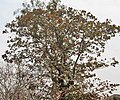Terminalia catappa
| Terminalia catappa subsp. var. | Indian almond, Kotamba | |||||||||||||||||||||||||||||||||||||||||||||||||||||||
|---|---|---|---|---|---|---|---|---|---|---|---|---|---|---|---|---|---|---|---|---|---|---|---|---|---|---|---|---|---|---|---|---|---|---|---|---|---|---|---|---|---|---|---|---|---|---|---|---|---|---|---|---|---|---|---|---|

|
|
| ||||||||||||||||||||||||||||||||||||||||||||||||||||||
| ||||||||||||||||||||||||||||||||||||||||||||||||||||||||
Terminalia catappa is a large tropical tree in the Leadwood tree family, Combretaceae. The tree has been spread widely by humans and the native range is uncertain. It has long been naturalised in a broad belt extending from Africa to Northern Australia and New Guinea through Southeast Asia and Micronesia into the Indian Subcontinent. More recently the plant has been introduced to parts of the Americas. Common names include , Bengal almond, Singapore almond , Ebelebo, Malabar almond, Indian almond, Tropical almond, Sea almond, Beach Almond, Talisay tree, Umbrella tree, Abrofo Nkatie (Akan) and Zanmande (creole).
It grows to 35 m ft tall, with an upright, symmetrical crown and horizontal branches. The Terminalia catappa has corky, light fruit that is dispersed by water. The nut within the fruit is edible when fully ripe,tasting almost like almond. As the tree gets older, its crown becomes more flattened to form a spreading, vase shape. Its branches are distinctively arranged in tiers. The leaves are large, 15 - 25 cm long and 10 - 14 cm broad, ovoid, glossy dark green and leathery. They are dry-season deciduous; before falling, they turn pinkish-reddish or yellow-brown, due to pigments such as violaxanthin, lutein, and zeaxanthin.
The flowers are monoecious, with distinct male and female flowers on the same tree. Both are 1 cm in in diameter, white to greenish, inconspicuous with no petals; they are produced on axillary or terminal spikes. The fruit is a drupe 5 - 7 cm long and 3 - 5.5 cm broad, green at first, then yellow and finally red when ripe, containing a single seed.
Terminalia catappa is widely grown in tropical regions of the world as an ornamental tree, grown for the deep shade its large leaves provide. The fruit is edible, tasting slightly acidic.
The wood is red, solid and has high water resistance.
| Standard Cyclopedia of Horticulture |
|---|
|
Terminalia catappa, Linn. Tropical Almond. Indian Almond. Myrobalan. Almendro. Amendoeira. Fig. 3787. A tall, stately tree, up to 80 ft. high, with horizontal branches arising from the primary axis in whorls 3-6 ft. apart: bark smooth, brownish gray: lvs. clustered at the ends of the young branchlets, alternate, entire, obovate, obtuse to subacuminate at the apex, attenuate toward the slightly auricled base, 6-12 in. long, 3-6 in. broad, coriaceous, glabrous above, very finely pubescent below, venation slightly raised on both surfaces but most prominent below; petiole stout, under 1 in. long, flattened above, rusty-pubescent: fls. whitish, upper ones staminate and lower ones perfect, in finely pubescent spikes up to 6 in. long; calyx-segms. acute, slightly concave, valvate in bud, finely pubescent; filaments subulate, inserted upon the hairy disk; anthers cordate: fr. broadly oval in outline, elliptical and winged in transverse section, 1 1/2 - 2 in. long, indehiscent, greenish or reddish, glabrous, with a firm, fleshy exocarp and a hard endocarp inclosing the oblong-elliptical seed; testa membranous, the cotyledons whitish, inrolled spirally. —Indigenous to beach forests of the Andaman Isl., but now cult. widely throughout the tropics; Schimper points out that the frs. are adapted for dispersal by ocean currents, the thick husk containing air-cells enabling them to float for a long time. The tropical almond (so-called, but not related to the true almond) is extensively planted in S. Fla., the W. Indies, Cent. and S. Amer., as a street and ornamental tree. Its greatest disadvantage seems to be that it is deciduous during the cold season (shedding its lvs. twice a year in Ceylon, according to Macmillan), but the rich reddish hues assumed by the foliage before falling make it very attractive. There are many fine avenues planted to it throughout the tropics. The nut seems to be much less esteemed in Amer. than in the Orient. Firminger describes it as "of a fine filbert-like flavor, with a crispness like that of a fresh walnut; beyond comparison the most delicious of any kind of nut the country (India) affords." He also states that the kernels, when removed from the husk, are generally served on the table in a plate of water. They yield a valuable oil, resembling almond oil, which is used in India. The tasar silkworm is fed on the lvs., according to Watt. In S. Fla. this is one of the most popular ornamental trees for street and avenue planting. It is not grown in Calif., and is probably too tender for most locations in that state. Prop. seems to be exclusively by seed. CH
|
Cultivation
- Do you have cultivation info on this plant? Edit this section!
Propagation
- Do you have propagation info on this plant? Edit this section!
Pests and diseases
- Do you have pest and disease info on this plant? Edit this section!
Species
Gallery
If you have a photo of this plant, please upload it! Plus, there may be other photos available for you to add.
branches with new leaves and flower spikes in Kolkata, West Bengal, India.
in Hyderabad, India.
in Hyderabad, India.
in Hyderabad, India.
in Hyderabad, India.
in Hyderabad, India.
in Hyderabad, India.
trunk in Kolkata, West Bengal, India.
tree in Kolkata, West Bengal, India.
tree in Kolkata, West Bengal, India.
old trunk in Kolkata, West Bengal, India.
fallen leaf in Kolkata, West Bengal, India.
fallen leaf (back side) in Kolkata, West Bengal, India.
branches with new leaves & flower spikes in Kolkata, West Bengal, India.
References
- Standard Cyclopedia of Horticulture, by L. H. Bailey, MacMillan Co., 1963
External links
- w:Terminalia catappa. Some of the material on this page may be from Wikipedia, under the Creative Commons license.
- Terminalia catappa QR Code (Size 50, 100, 200, 500)


















